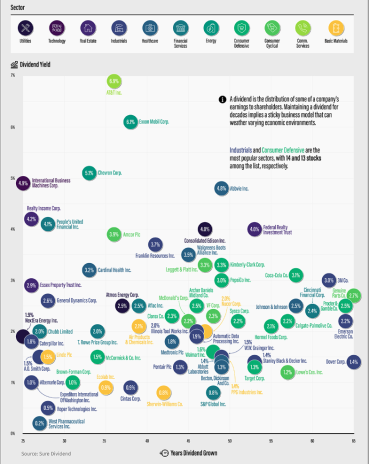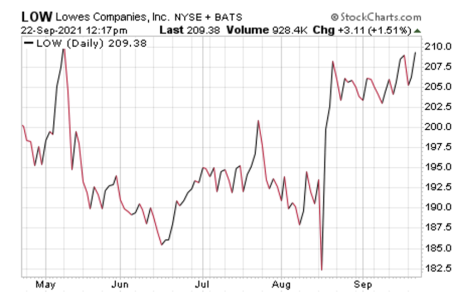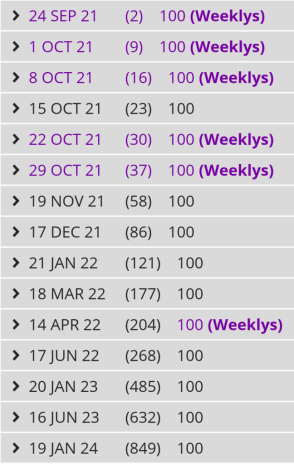Today I want to discuss how to create a portfolio of Dividend Aristocrats using a poor man’s covered call options strategy.
In a market environment shaped by low rates and low yields in the fixed income arena, Dividend Aristocrats using a poor man’s covered call approach might be an attractive alternative for some investors, especially those seeking steady income.
[text_ad use_post='261460']
Briefly, Dividend Aristocrats are a basket of roughly 65 equities that have managed to grow their dividends per share every year for the last 25 years or more. The reason I, among others, like Dividend Aristocrats is because they offer investors some of the safest stocks in the market.
Here is a graphic depicting all the Dividend Aristocrats in the market today:
Source: Visual Capitalist
Couple Dividend Aristocrats with a poor man’s covered call strategy and you have an incredibly powerful strategy over the long-term. As many of you are already aware, I’ve stated numerous times that one of my favorite options strategies is the poor man’s covered call.
It’s simple, straight-forward and easy to manage. Poor man’s covered calls don’t require buying 100 shares of stock. They allow you to use far less capital, while still receiving the same benefits of a covered call strategy. And the alternative strategy gives you a far greater return on your capital.
In fact, in most cases, it costs 65% to 85% less to use a poor man’s covered call strategy. The savings in capital required should be reason enough to at least consider using the strategy. And I’m certain after reading this you will indeed find the strategy appealing enough to consider.
A Short Background on Poor Man’s Covered Calls
A poor man’s covered call is an inherently bullish strategy that is the same in every way to that of a covered call strategy, with one exception. Rather than spend an inordinate amount of money to purchase at least 100 shares of stock, you have the ability to buy what is essentially a stock replacement. The replacement? An in-the-money LEAPS call contract.
LEAPS, or long-term equity anticipation securities, are options with at least one year left until they are due to expire. The reason we choose to use LEAPS as our stock replacement is because LEAPS don’t suffer from accelerated time decay like shorter-dated options.
My Approach to Poor Man’s Covered Calls Using Dividend Aristocrats
There are numerous ways to approach a poor man’s covered calls options strategy. My preference is to use LEAPS that have at least two years left until expiration.
As for which of the 65 Dividend Aristocrats to choose, I prefer to go with the stalwarts that have high liquidity in the options market and the longest track record of increasing dividends.
Here is a list of the top 10 that I might consider. Ultimately, you must decide what works best for you given a variety of factors, but the list below is certainly a good start.
Let’s take a look at Lowe’s (LOW). It’s an expensive stock, yet one of most consistent performers the market offers. However, the cost can be mitigated through the use of a poor man’s covered call. I’ll explain below.
As you can see in the chart below the stock is currently trading for 209.38.
If we followed the route of the traditional covered call we would need to buy at least 100 shares of the stock. At the current share price, 100 shares would cost $20,942.
For some investors, the cost of 100 shares can be prohibitive, especially if diversification amongst a basket of stocks is a priority. Therefore, a covered call strategy just isn’t in the cards … and that’s unfortunate.
But with a poor man’s covered call options strategy you can typically save 65% to 85% off the cost of a covered call strategy.
So again, rather than purchase 100 shares or more of stock, we only have to buy one LEAPS call contract for every 100 shares we wish to control.
As I said before, my preference is to buy a LEAPS contract with an expiration date around two years. Some options professionals prefer to only go out 12-16 months, but I prefer the flexibility the two-year LEAPS offers.
The image below shows every expiration cycle available for Lowe’s. Again, I want to go out roughly two years in time. The January 19, 2024 expiration cycle with 849 days left until expiration is the longest dated expiration cycle, but I don’t want to go out that far in time. The June 16, 2023 with 632 days until expiration works for me.
When my LEAPS reach 8-12 months left until expiration I then begin the process of selling my LEAPS and reestablishing a position with approximately two years left until expiration.
Once I have chosen my expiration cycle, I then look for an in-the-money call strike with a delta of around 0.80.
When looking at Lowe’s option chain I quickly notice that the 155 call strike has a delta of 0.80. The 155 strike price is currently trading for approximately $62.60. Remember, always use a limit order. Never buy an option at the ask price, which in this case is $63.35.
So, rather than spend $20,942 for 100 shares of LOW, we only need to spend $6,260. As a result, we are saving $14,682, or 70.1%. Now we have the ability to use the capital saved to diversify our premium amongst other securities, if we so choose.
After we purchase our LEAPS call option at the 155 strike, we then begin the process of selling calls against our LEAPS.
My preference is to look for an expiration cycle with around 30-60 days left until expiration and then aim for selling a strike with a delta ranging from 0.20 to 0.40, or a probability of success between 60% to 85%.
As you can see in the options chain below, the 215 call strike with a delta of 0.33 falls within my preferred range.
We can sell the 215 call option for roughly $2.60.
Our total outlay for the entire position now stands at $6,000 ($62.60-$2.60). The premium collected is 4.2% over 30 days, or 50.4% annually. That’s right, 50.4% annually.
If we were to use a traditional covered call our potential return on capital would be less than half, or 1.2% every 30 days, or 14.4% annually. Plus, the annual dividend of 1.53%.
However, the overall difference in total return is significant between the two approaches: 34.5%.
And remember, the 4.2% is just the premium return; it does not include any increases in the LEAPS contract if the stock pushes higher. Moreover, we can continue to sell calls against our LEAPS position for another 8-12 months, thereby generating additional income or lowering our cost basis even further.
An alternative way to approach a poor man’s covered call, if you are a bit more bullish on the stock, is to buy two LEAPS for every call sold. This way you can benefit from the additional upside past your chosen short strike, yet still participate in the benefits of selling premium.
Regardless of your approach, you can continue to sell calls against your LEAPS as long as you wish. Whether you hold a position for one expiration cycle or 12, poor man’s covered calls give you all the benefits of a covered call for significantly less capital.
Take the time to learn the strategy and, as always, if you have any questions please feel free to email.






